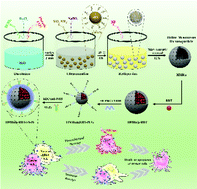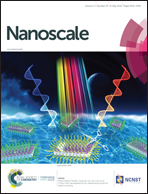Hollow mesoporous ruthenium nanoparticles conjugated bispecific antibody for targeted anti-colorectal cancer response of combination therapy†
Abstract
Combined treatment based on tumor-targeted nanoparticles has become one of the most promising anticancer strategies. Moreover, bispecific antibodies have been designed as linkers to promote the interaction between natural killer (NK) cells and tumor cells, while triggering NK cell-mediated target cell lysis. Here, we adopted a novel design that uses PEGylated hollow mesoporous ruthenium nanoparticles as a carrier to load the fluorescent anti-tumor complex ([Ru(bpy)2(tip)]2+, RBT) and a conjugate with bispecific antibodies (SS-Fc). By accurately targeting carcinoembryonic antigen overexpressed in colorectal cancer cells, HMRu@RBT-SS-Fc significantly improved selective penetration in vitro. The functionalized nanocomplex effectively engaged NK cells and possessed excellent near infrared-sensitive cytotoxicity. Systematic in vivo studies clearly demonstrated the high tumor targeting and anticancer activity in heterotopic colorectal tumor model via combined photothermal and immune therapy. This nanosystem establishes a new platform for future image-guided drug delivery and highly efficient cancer therapy.



 Please wait while we load your content...
Please wait while we load your content...